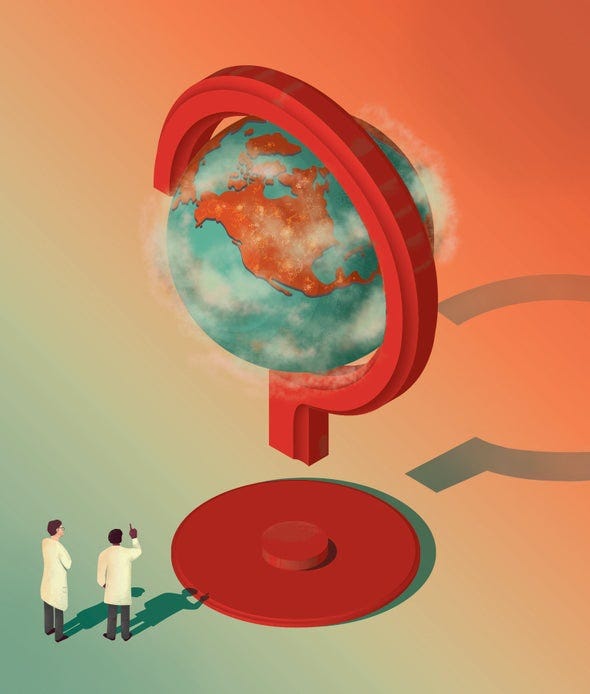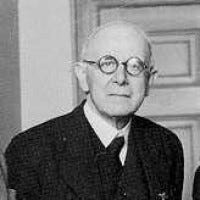Trump “Will Be Indicted”
At least according to someone who seems to know a fair bit (though I’d just add my own deeply expert view here — who knows?). For those who like to read the form before the game.
MC: Your area of expertise is financial crimes. So, the former president took the Fifth a gazillion times with New York Attorney General Tish James. Tell me what you think of the case the state of New York is putting together.
JT: I’ve always thought the case is strong, as is the overlapping case that the New York district attorney, Alvin Bragg, is investigating. It’s hard to know all the stuff she’s investigating, but my understanding is that she’s looking at state tax fraud at the civil level and at falsifying business records. Because of the civil case, the burden of proof is much lower. Because the business is incorporated in New York, one of the remedies is to dissolve that corporation.
MC: So Trump misrepresented the value of his assets?
JT: They treated assets as if they were extremely valuable when the value would benefit him and treated them as not as valuable when it wouldn’t. You want the property to look less valuable when you pay tax. If you’re getting a bank loan, you would like the collateral to seem more valuable. He was engaged in kindergarten cooking of the books, right? This is not Enron.


Cory Doctorow’s latest — with Oz IP academic Rebecca Giblin


Protestants keep toasters in cupboards
A great post on resolving conflict. But before you start, watch the five minute video (though it’s slightly different to the clip the post uses)!
You don’t resolve significant conflicts by getting all the protagonists in a room facilitated by someone with a neo-colonial, white liberal ideological stance trying to assimilate people into their idea of what is good. You will always get a temporary effect and reported outcomes that will secure further funding and your workshop might, on occasion act as a catalyst for some more substantial change – indeed the fact that you are able to hold the workshop may be an indicator that change is now starting to emerge. But, and this is the main point of my post – and those two smiles at the end of the scene referenced, where you start to realise that you have something in common with your ‘enemy’.
Back in the 70s, I was a very junior member of a different type of peace initiative in which we took mixed groups of three or five (the asymmetry was important) from both sides of the ironically named ‘Peace Walls’ and dumped them into the shanty towns of Latin America to work together. They pretty soon discovered they had more in common than they realised and, critically, they had a conversation about their differences at a time and place of their own choosing and in their own language without any external facilitation. Another example of this is the film The Journey which is a largely factual account of how Ian Paisley and Martin McGuinness, leaders of the two communities, found a way to understand each other at a personal level by having to live through adversity together again without facilitation – although the overall theme of the film is that the situation was set up to try and make that happen. Another example: I’ve always loved since I was a teenager is Giovanni Guareschi’s stories of Don Camillo and Peppone, the former the Catholic Priest of a sleeping village on the River Po, the latter the Communist Mayor. A delight, if only for the way the priest is told off by the Crucified Christ in his prayers. The two are in a constant state of warfare but in their hearts, they both care for their people. That is powerfully shown in one story where they both end up repainting the crib figures in the build-up to Christmas.
I would summarise all of this as follows:
The heart of any solution to conflict lies in creating the conditions for empathy between the antagonists at a micro level through action, where talking arises from mutual action and respect not mediation.
Nukes and renewables on a level playing field at last
Zaporizhzhia nuclear plant; a potential disaster? Or an actual one?
UN Secretary-General António Guterres called attacking a nuclear plant "suicidal". I wish that were true! Unfortunately, it isn't.
The 6 reactors normally provide about 20 percent of Ukraine's electricity. That's about 8 million people without power; including hospitals, water pumping stations, fuel pumping stations and so on.
This is already a disaster of major proportions. Talking about it like it's a possible problem is to ignore the mundane but deadly nature of long-term power cuts.
Sure, it will be hard to count the deaths. They will just be waves on an ocean of tragedies. In most wars, it isn't the fighting that ends up being the most deadly. It will only be after the fighting has stopped that the death count can compared with normal years to find full impact.
On the other hand: Noah Smith
We can … pretty clearly see the future of nuclear power in our energy mix. And it is a very modest, government-dependent future. We are probably going to need some modest amount of nuclear in order to shore up the intermittency of renewables (though much less than nuclear boosters think). But it is going to be absolutely pulling teeth to get these built — this is not a situation where the government can simply deregulate and watch nuclear plants spring up around the country. Our government is going to have to shell out big bucks to support nuclear every step of the way.
Royalist Generalissima: Revisionist history of Charles I’s wife Henrietta Maria
She was daughter, sister, wife or mother to five kings and two queens. On her wedding day, her pale blue velvet train was ostensibly held by three princesses of the blood, but so heavily encrusted was it with golden embroidery that a man had to walk concealed beneath it to carry the weight. Such a start in life might seem to presage a pleasant existence of leisure and luxury, but the career of Henrietta Maria, a Bourbon princess by birth and a Stuart queen by marriage, was as full of trouble and strife as the most harrowing of hard-luck case histories.
In her thirties, she lived through a civil war that split Charles’s three kingdoms. She went abroad to raise arms and money, leaving her husband and their children behind. Returning, she invaded England at the head of an expeditionary force. On campaign, she endured bombardment and near-starvation. By the end of the war she was unrecognisable – emaciated and with teeth described variously as resembling boars’ tusks and ‘protruding from her mouth like guns from a fort’. Her children were imprisoned. When she was thirty-nine, her husband was publicly decapitated.
A must read thread: Driving our teachers nuts

Nice racy review of Susan Sontag bio
Melinda Harvey enjoyed herself writing this review as a string of Qs and As which was a nice change in the often ponderous Sydney Review of Books.
– Does Moser explain exactly why Susan got to be so famous?
She was charismatic without trying. She was beautiful without effort. She had energy to burn, and even then she took amphetamines to eliminate the need to sleep. In the early years especially she would read and write and view things around the clock, only getting up, Moser says, ‘to pee or to empty the ashtray, or get her next coffee’. She was, in her own words, ‘violently, naively ambitious’.
– That doesn’t explain how a critic got to be so famous.
She wrote the first truly contemporary criticism. She was one of the first to bridge the divide between high and popular culture: ‘just because I love Dostoevsky doesn’t mean that I can’t love Bruce Springsteen’. She had the knack of arresting juxtapositions: ‘the feeling (or sensation) given off by a Rauschenberg painting might be like that of a song by the Supremes’. She had the knack of being epigrammatic: ‘Religion is probably, after sex, the second oldest resource which human beings have available to them for blowing their minds’. She wrote appreciatively: as she puts it in the note to Against Interpretation, hers was a criticism of ‘passionate partiality’.
– Nor does that.
Her criticism was championed. Roger Straus published her essays as collections, he paid her generous advances, he kept all her books in print during her lifetime. She also had the talent – like Woody Allen’s Zelig …
– She literally appears in Zelig.
…to be in the right place at the right time: Warhol’s Factory in the 1960s, Vietnam in the 1970s, Berlin in the 1980s, Sarajevo in the 1990s.
– Why did Susan think she became a famous literary critic?
‘You find some limb, and you go out on it’.
– Why did her contemporaries think she became a famous literary critic?
Norman Podhoretz explained it in his 1967 memoir, Making It: ‘Her talent explains the rise itself, but the rapidity with which it was accomplished must be attributed to the coincidental availability of a vacant position in the culture. That position was Dark Lady of American Letters, a position that had originally been carved out by Mary McCarthy in the thirties and forties. But Miss McCarthy no longer occupied it, having recently been promoted to the more dignified status of Grande Dame as a reward for her long years of brilliant service.’ She was, in other words, an exceptional woman.


A bit of substack propaganda — good propaganda
A few years ago, I was given a tour of Facebook’s headquarters in Menlo Park. It’s a beautiful campus, with modern buildings, comfortable furnishings, striking murals—all the things you’d expect of a mega-moneyed tech company. But there was also quite a bit more. The main thoroughfare between buildings is modeled on Disneyland and dotted with the kinds of amenities that satisfy all the dreams of an eternal child: a candy store serving free ice cream; a video arcade parlor; a burger joint; a workshop for screen-printing posters; an on-site laundry service. No normal human being needs any of this stuff at their place of work, but Facebook clearly decided that these perks help attract talented employees and especially software developers, Silicon Valley’s holiest of holies.
It was fun to visit and fantasize about endless scoops of Cookies & Cream, but I also left with a slight queasiness. It didn’t feel right that software developers were treated like gods while writers—my people—were treated like paupers. During that time, I had a friend who worked in The Guardian’s U.S. West Coast bureau, housed in an Oakland WeWork. Their version of an office perk came when a startup based in the same WeWork left out their uneaten sandwiches after a catered event.
Social AI is Coming: a glimpse of the future?
Justin Murphy thinks the Web3 environment Urbit is a big deal. He’s a generous fellow and is even giving away Urbit real estate.
It's never been possible for an arbitrary number of average people to combine Turing-complete computation and financial liquidity within one seamless, integrated operating system and graphical user interface.
If these conditions ever come to hold, we should expect to see totally new kinds of social-computational formations.
I'm interested in Urbit because it's the first operating system on track to make these conditions hold.
I thought it would be helpful to articulate this hypothesis more fully, with reference to applications already operating on the Urbit network.


Interesting long tweet thread on Rushdie

Carbon-Reduction Plans Rely on Tech That Doesn’t Exist
It’s an interesting question how one should factor technologies into one’s thinking for what will happen several decades out — especially if they’re experiencing strongly declining costs right now. And then there are technologies that haven’t been made to work at any reasonable scale or cost. But they’re somehow in global plans to get to net zero by 2050 too.
The IPCC models depend heavily on carbon capture and storage, also called carbon capture and sequestration (either way, CCS). Some advocates, including companies such as ExxonMobil, say CCS is a proven, mature technology because for years industry has pumped carbon dioxide or other substances into oil fields to flush more fossil fuel out of the ground. But carbon dioxide doesn't necessarily stay in the rocks and soil. It may migrate along cracks, faults and fissures before finding its way back to the atmosphere. Keeping pumped carbon in the ground—in other words, achieving net negative emissions—is much harder. Globally there are only handful of places where this is done. None of them is commercially viable.

Henry Oliver: a great review.
Don’t read this book. Anyone who pays serious attention to Mrs Palfrey at the Claremont ought come away from it feeling less able to cope with their life. Like grief, this will be a feeling that vanishes to deceive. Just when you are enjoying a sunny spell as you walk down the street, you will remember, in the words of the poet, that like the generations of leaves so are the lives of mortal men. And that, before the branch you perch on becomes a bare ruined choir, you will have to grow old.
I will say it again, just so we are clear. Don’t read this book. I mean this like I mean it when I tell my children not to cross the road without me. Odds are, you’ll be fine. But this isn’t a risk you ought to be taking. Most of us know less than nothing about old age. There’s no mystery about why loneliness is the biggest health problem most elderly people have: we are not brave enough to see our future in such graphic detail. This masterpiece of a novel may or may not be the way you want to learn. And if you are already well versed in the impending horrors of your dotage, you should only approach this book on a sunny day when there’s a bottle of good sherry waiting for you afterwards. …
Elizabeth Taylor has a genius not just for simple misery but for unnoticed bleak oblivion. So, only when you are ready should you read Mrs Palfrey at the Claremont. Read it early or read it late. This is not for the faint hearted or the middle aged. If you think you need to scare yourself in oder to make the most of your life now, then you must do nothing until you have read it. Just be warned: I told you not to.


Gillian Dooley on her new book on Iris Murdoch: Music, Sounds and Silences
I enjoyed the low-key, feminine intelligence of this discussion.
Fruitcake watch
























